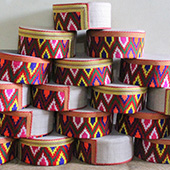Design Resource
Kullu Cap - Himachal Pradesh
Traditional Hat
by
Handloom weaving is done on the four-pedal Loom. The weavers do weaving at home, and most men are involved in the process. Warp yarn is loaded to the beam, where the old warp yarn is preserved for continuing the new cloth weaving. The threads are knotted to the past yarn present in heddles, and the shaft is fixed to the handloom where the weaving process occurs. Weaving is an interlocking of two separate yarns at right angles like weft thread and warping yarn, which makes a fabric. In the handloom, the weft yarn is spun to the small bobbins that are placed inside the wooden instruments called a shuttle. The weft yarn-loaded shuttle is moved between the warp yarns, which makes the weaving process appear. Heddles hold the warp yarns in the Loom. The alternate warp yarn is picked up by one heddle, and the rest of the other warp yarn is owned by other heddles. The movement of the pedals moves two heddles up and down, which makes the warp into two parts and opens a small passage every time the pedaling is done. That passage is where the shuttle is moved from right to left and left to right, correspondingly. Thus, the weft yarn is weaved and interlaced between the alternate warp yarns. The shuttle can be moved by the hand or pushed with force with a small hand mechanism applied that is called a fly shuttle. Once the shuttle is moved, the weft yarn is tightened and advanced towards the previous weaved yarn with the help of a reed beater. Reed is a wooden block with tiny passages made for the warp yarn to insert. Reed is moved to and fro for tightening the weft yarns. This is like a repetitive process, which happens only when a weaver pedals with the legs, runs the fly shuttle with his/her right hand and moves the reed beater with the left side. All these movements should occur in correspondence to acquire the smooth flowing of the weaving process.
Cutting: For making a cap, the woolen cloth is cut in a round shape and also cut like a strip. The woolen fabric is cut in a round shape for making the crown of the cap according to the required measurement. The two layers are required for the top of the cap. Then the necessary piece of strips is cut for the sideband according to the measure.
Stitching: Firstly, the top portion of the cap is prepared by attaching the two round-shaped cloths. The canvas is placed in between the two finished-shaped fabrics, and circular stitching is done on the machine. The canvas gives stiffness to the cap. Then both the edges of the strip and top are stitched together using the sewing machine. The front part of the cap is attached to a designed border. At last, the prepared cap is put upon the wooden block and ironed to remove wrinkles.














